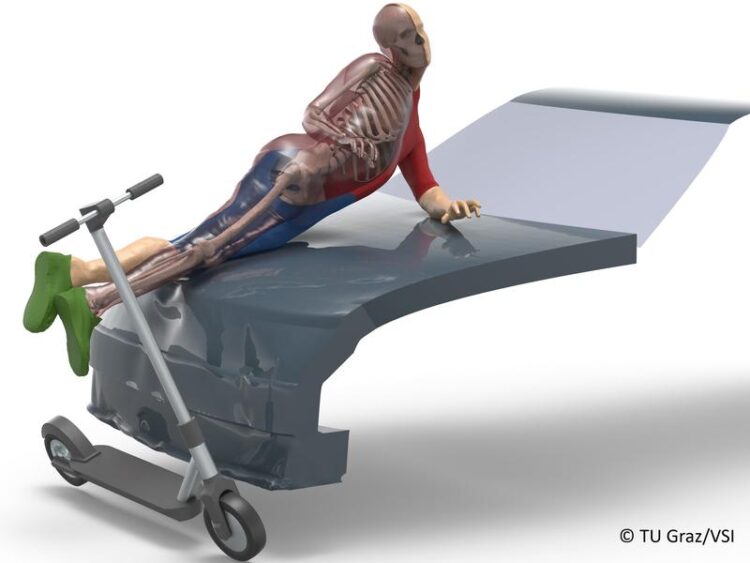E-Scooter Accidents: More Helmets and Less Speed Reduce the Injury Risk

The simulation of a collision of an e-scooter and a car.
(c) VSI - TU Graz
A team from the Vehicle Safety Institute at TU Graz has used Human Body Models to investigate accidents involving electric scooters and identified the most important factors for preventing serious injuries.
The use of e-scooters has increased significantly in recent years, but so has the number of accidents involving this relatively new form of transport. At the same time, knowledge about injury mechanisms in this area was still very limited. In the project SURF, funded by Zukunftsfonds Steiermark, the Vehicle Safety Institute at Graz University of Technology (TU Graz) investigated this topic using Human Body Models and derived recommendations to reduce the injury risk in e-scooter accidents.
Put on a helmet, decrease speed and get off the pavement
As is also the case for other groups of vulnerable road users, the study found that when riding an e-scooter, a helmet can reduce the risk of head injuries drastically – in this case by up to 44 percent. It also showed that a ban on e-scooters on pavements and footpaths makes sense. The simulations showed that collisions with pedestrians often result in serious injuries. In addition to the ban, a speed limit would bring more safety in this regard – the same applies to single e-scooter accidents. For example, the risk of head injuries to pedestrians is reduced by up to 49 percent when the collision speed is reduced from 25 km/h to 15 km/h. In contrast, in collisions with passenger cars, it is mainly the speed of the car that plays a major role in the level of injury risk. Collisions with cars travelling at 40 km/h can cause severe to fatal head injuries to e-scooter riders.

The team of project SURF (from left to right): Martin Schachner, Desiree Kofler, project director Christoph Leo and research group leader Corina Klug from the Institute for Vehicle Safety at TU Graz. (c) Helmut Lunghammer / TU Graz
A reduction in the maximum permitted speed of e-scooters would also benefit unexperienced drivers. As part of the study, there were experiments with volunteers in which the driving behaviour of the e-scooter riders was examined in order to determine their riding pose for simulations with Human Body Models. This showed that even unexperienced drivers often rode at the top speed of their e-scooters, although they were still very unsafe on the road.
From literature analysis to simulation
In order to obtain realistic results for the study, the team led by project manager Christoph Leo, research group leader Corina Klug, project assistant Desiree Kofler and university assistant Martin Schachner first analysed the accident events on the basis of literature, accident records and videos in order to derive boundary conditions for the simulation. Subsequently, the tests with volunteers to determine the riding pose were combined with Human Body Model simulations, which were developed with the involvement of the Vehicle Safety Institute, in order to be able to predict injuries in accidents. From this, a simulation matrix could be created that made it possible to answer the project questions.
“Because e-scooters are a very young form of mobility, we broke new ground in this project in order to be able to analyse the injury risk in e-scooter accidents. There were previously not many studies on this,” explains Christoph Leo. “However, after analysing the simulated accidents with the Human Body Models, a very clear picture emerged. Wearing a helmet and reducing the driving speed, especially around pedestrians, can prevent many serious injuries. It would be even more important that e-scooters comply with the ban on driving on pavements and footpaths. In general, the risks of this form of mobility seem to be underestimated, which is why an increasing number of injuries is expected in the coming years. You are safer in road traffic on foot or by bike and simultaneously do something good for yourself and the environment. Anyone who really needs to ride an e-scooter, please at least put on a helmet.”
Wissenschaftliche Ansprechpartner:
Christoph LEO
Dipl.-Ing. BSc
TU Graz | Vehicle Safety Institute
Phone +43 316 873 30364
christoph.leo@tugraz.at
Media Contact
All latest news from the category: Studies and Analyses
innovations-report maintains a wealth of in-depth studies and analyses from a variety of subject areas including business and finance, medicine and pharmacology, ecology and the environment, energy, communications and media, transportation, work, family and leisure.
Newest articles

Retinoblastoma: Eye-Catching Investigation into Retinal Tumor Cells
A research team from the Medical Faculty of the University of Duisburg-Essen and the University Hospital Essen has developed a new cell culture model that can be used to better…

A Job Well Done: How Hiroshima’s Groundwater Strategy Helped Manage Floods
Groundwater and multilevel cooperation in recovery efforts mitigated water crisis after flooding. Converting Disasters into Opportunities Society is often vulnerable to disasters, but how humans manage during and after can…

Shaping the Future: DNA Nanorobots That Can Modify Synthetic Cells
Scientists at the University of Stuttgart have succeeded in controlling the structure and function of biological membranes with the help of “DNA origami”. The system they developed may facilitate the…



